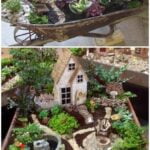Are you looking to transform your outdoor space into a stunning and functional area with unique features? L shaped landscaping ideas can help you achieve just that. In this article, we will explore the benefits of L shaped landscaping, different types, planning tips, plant and tree options, hardscaping ideas, incorporating water features, lighting options and essential maintenance tips.
L shaped landscaping offers an innovative approach to designing outdoor spaces that not only enhance the beauty of your property but also maximize its functionality. The unique shape allows for versatility in layout and design, making it suitable for various types of properties. Whether you have a large backyard or a small garden, L shaped landscaping ideas can be customized to suit your specific needs and preferences.
In the following sections, we will delve into the various aspects of L shaped landscaping to give you a comprehensive understanding of its benefits and how to successfully plan and execute this style in your outdoor space. From choosing the right plants and trees to adding hardscaping elements and incorporating water features, we have got you covered with all the essential information you need to create a stunning L shaped landscape.
So let’s dive in and explore the world of L shaped landscaping ideas.
Benefits of L Shaped Landscaping
L shaped landscaping offers numerous benefits to homeowners, including maximizing the use of space and creating a visually appealing outdoor area. Here are some advantages of opting for an L shaped landscape design:
1. Space Optimization: The L shape allows for the utilization of corners and irregular spaces that may be challenging to work with in a traditional rectangular or square layout. This provides more area for planting, seating, and other features.
2. Privacy and Division: The L shape can be used to create distinct zones within the landscape, such as a secluded reading nook or a separate dining area. It also provides opportunities for incorporating privacy hedges, fences, or walls to create secluded spaces.
3. Visual Interest: The unique shape of an L shaped landscape adds visual interest and dimension to the overall design. It allows for the creation of interesting lines and angles that can enhance the aesthetic appeal of the outdoor space.
Incorporating an L shaped landscaping design into your outdoor space can offer practical and aesthetic benefits that enhance the overall functionality and appearance of your property. Whether you have a large backyard or a small garden, there are numerous ways to maximize the potential of an L shaped layout and create a beautiful outdoor environment.
By carefully planning and selecting appropriate plants, trees, hardscaping elements, water features, lighting, and maintenance strategies, you can transform your outdoor space into a stunning retreat that suits your lifestyle and preferences.
Types of L Shaped Landscaping
When it comes to L shaped landscaping, there are a variety of design options to choose from. One popular option is the use of diagonal and angular lines within the landscape to create a sense of movement and flow. This can be achieved through the use of pathways, plant beds, and hardscaping elements. Another type of L shaped landscaping involves creating separate zones within the space, such as an outdoor dining area or a secluded garden nook.
In addition to these design options, L shaped landscaping can also incorporate unique features such as raised planters and retaining walls. These elements not only add visual interest to the landscape, but they can also help define different areas within the space.
Furthermore, when planning your L shaped landscape, it’s important to consider how each zone will be utilized and what type of plants and trees will work best in each area. For example, if you have an outdoor entertaining space with a fire pit, you may want to include low-maintenance plants that won’t be damaged by heat.
Overall, there are countless possibilities for creating a stunning and functional L shaped landscape. Whether you prefer clean lines and modern designs or naturalistic and rustic styles, there are plenty of options to suit your taste and needs.
| Design Option | Description |
|---|---|
| Diagonal and Angular Lines | Create movement and flow in the landscape using pathways, plant beds, and hardscaping elements. |
| Zoned Spaces | Create separate areas within the landscape such as dining spaces or garden nooks. |
| Raised Planters & Retaining Walls | Add visual interest while defining different areas within the space. |
Planning Your L Shaped Landscape
When planning your L shaped landscape, there are several factors to consider in order to maximize the potential of your outdoor space. The unique shape of an L shaped yard presents both opportunities and challenges when it comes to landscaping. One of the key aspects to take into consideration is how you will create flow and cohesion between the two separate areas of the yard created by the L shape.
First, it’s important to define the different zones within the L shaped layout. Consider dividing the space into distinct areas such as a dining area, a relaxation area, and a play area if you have children or pets. Each zone can be designated for a specific function and tailored to meet your needs based on how you intend to use the space.
Secondly, think about how you can create unity between the two parts of the yard. You can do this through strategic planting, pathways, or hardscaping elements that tie both sections together. Creating visual continuity will help make the entire space feel connected rather than disjointed.
Lastly, take into account how your planned landscaping elements will work with respect to sun exposure, drainage, and any existing structures or features in your yard. Proper planning will ensure that your L shaped landscape is not only visually appealing but also functional and practical for everyday use.
| Aspect | Description |
|---|---|
| Zones | Divide the space into distinct areas such as dining area, relaxation area, and play area. |
| Unity | Create visual continuity between both parts of the yard using strategic planting and hardscaping elements. |
| Practicality | Consider sun exposure, drainage, and existing structures when planning landscaping elements. |
Plants and Trees for L Shaped Landscapes
When it comes to l shaped landscaping ideas, choosing the right plants and trees is crucial to achieve a balanced and visually appealing outdoor space. The unique shape of an l shaped landscape allows for the incorporation of a variety of plant species, from ground cover to tall trees, creating different layers and textures within the garden. When selecting plants and trees for your l shaped landscape, consider factors such as climate, soil type, sun exposure, and maintenance requirements.
Native Plants and Trees
One great way to ensure a thriving l shaped landscape is to incorporate native plants and trees into your design. Native species are well adapted to the local climate and soil conditions, making them low-maintenance options that require less water and fertilizer. Additionally, native plants provide important habitats for local wildlife, including birds, butterflies, and pollinators.
Evergreen Trees
Incorporating evergreen trees in your l shaped landscaping can provide year-round interest and privacy. These trees maintain their foliage throughout the year, adding color and texture even during the winter months. Consider incorporating varieties such as pine, cedar, or cypress for their unique shapes and foliage colors.
Flowering Shrubs
To add a pop of color and fragrance to your l shaped landscape, consider including flowering shrubs. These plants not only provide beautiful blooms but also attract beneficial insects to your garden. Look for species such as hydrangeas, azaleas, or butterfly bushes to bring color and life to your outdoor space.
By carefully choosing the right mix of plants and trees for your l shaped landscape, you can create a harmonious and inviting outdoor environment that enhances the overall appeal of your property. Whether you opt for native species for their environmental benefits or select flowering shrubs for their visual impact, thoughtful plant selection is essential in achieving a successful l shaped landscaping design.
Hardscaping Ideas for L Shaped Landscapes
When it comes to creating a visually appealing and functional L shaped landscape, hardscaping plays a crucial role. Hardscaping involves the use of non-living elements in your landscape design, such as pathways, patios, retaining walls, and other structures. The right hardscaping elements can help define the different areas within an L shaped landscape and create visual interest.
Defining Separate Spaces
One of the key hardscaping ideas for L shaped landscapes is to use different materials to define separate spaces within the layout. For example, you could use different types of paving stones or tiles to differentiate the patio area from the walkways or garden beds. This helps create a sense of organization and structure within your outdoor space.
Creating Focal Points
Incorporating hardscape elements like a fire pit, fountain, or pergola can create focal points within each section of the L shaped landscape. These features not only add visual interest but also provide functional benefits. A fire pit can extend the usability of your outdoor space into cooler months, while a fountain adds soothing sounds and visual appeal.
Utilizing Vertical Hardscaping
In an L shaped landscape, it’s important to consider vertical hardscaping elements such as trellises, arbors, or vertical planters. These can help maximize space by adding interest and greenery to vertical surfaces. Consider incorporating climbing plants like ivy or jasmine to soften hard edges and add a touch of nature to your hardscape design.
By incorporating these hardscaping ideas into your L shaped landscaping project, you can create an outdoor space that is not only visually appealing but also functional and enjoyable for years to come. Whether you’re defining separate areas, creating focal points, or utilizing vertical hardscaping elements, thoughtful consideration of your hardscape design will enhance the overall look and feel of your L shaped landscape.
For more inspiration on l shaped landscaping ideas visit “Your Landscaping Company” website today.
How to Incorporate Water Features in L Shaped Landscaping
A water feature can be a beautiful and tranquil addition to any l shaped landscaping design. Whether it’s a small fountain, pond, or stream, incorporating water into your l shaped landscape can add visual interest and create a soothing atmosphere. Here are some ideas on how you can incorporate water features into your l shaped landscaping:
1. Fountains: Adding a fountain to your l shaped landscape can create a focal point and provide the calming sound of running water. There are many different styles and sizes of fountains to choose from, whether you prefer a modern, sleek look or a more traditional tiered design.
2. Ponds: If you have the space, consider adding a pond to your l shaped landscape. Ponds can support a variety of aquatic plants and even fish, adding another layer of interest to your outdoor space. You can also include rocks and boulders around the perimeter for a more natural look.
3. Waterfalls: A waterfall can be an impressive and eye-catching addition to an l shaped landscape. It can be incorporated into a retaining wall or created as part of a larger water feature. The sound of cascading water can create a peaceful ambiance in your outdoor space.
Incorporating water features into your l shaped landscaping design requires careful planning and consideration of factors such as maintenance and safety. However, with the right approach, adding water elements can enhance the beauty and enjoyment of your outdoor environment.
Lighting Ideas for L Shaped Landscapes
When it comes to L shaped landscaping, incorporating the right lighting can make all the difference in creating a beautiful and functional outdoor space. Lighting not only enhances the aesthetics of your landscape but also provides safety and security, allowing you to enjoy your garden even after the sun goes down. There are various lighting ideas that you can consider for your L shaped landscape, depending on your preferences and the overall design of your outdoor space.
One popular lighting idea for L shaped landscapes is the use of pathway lights to illuminate walkways, garden paths, and entrances. These lights not only add a touch of charm and elegance to your landscape but also ensure safe passage for you and your guests during the evening hours. Additionally, using spotlights to highlight certain focal points such as trees, sculptures, or architectural features can create a dramatic effect in an L shaped garden.
Another great lighting option for L shaped landscapes is the use of string lights or fairy lights to create a magical ambiance. These types of lights can be draped over pergolas, trellises, or wrapped around trees to add a cozy and enchanting feel to your outdoor space. Furthermore, incorporating uplights at the base of trees or shrubs can create a stunning silhouette effect and add depth and dimension to your L shaped landscaping.
Incorporating lighting into your L shaped landscape design requires careful planning and consideration of various factors such as the type of fixtures, placement, and energy efficiency. Whether you prefer a soft and subtle glow or bold and impactful lighting effects, there are countless possibilities to explore when it comes to illuminating your L shaped outdoor space.
Maintenance Tips for L Shaped Landscapes
Maintaining an L shaped landscape can be a bit more challenging than maintaining a traditional rectangular or square-shaped landscape. However, with proper care and attention, your L shaped landscaping can remain beautiful and healthy. Here are some maintenance tips to ensure your L shaped landscape stays in top condition.
One of the most important maintenance tasks for an L shaped landscape is regular pruning and trimming of plants, trees, and shrubs. Because of the unique shape of an L shaped landscape, certain areas may receive more sunlight or water than others, leading to uneven growth. Regular trimming and pruning will help maintain a balanced appearance and prevent overgrowth.
Another crucial maintenance tip for L shaped landscapes is proper irrigation. Since different areas of your landscape may have varying water needs, it’s important to adjust your irrigation system accordingly. Consider installing separate zones for different sections of your L shaped landscape to ensure that each area receives the appropriate amount of water.
In addition to regular pruning and proper irrigation, it’s essential to keep an eye on potential drainage issues in an L shaped landscape. With its unusual shape, water may collect in certain areas, leading to drainage problems and potential damage to plants and hardscaping elements.
Be sure to address any drainage issues promptly by installing French drains or adjusting the grading of the landscape as needed. By taking these maintenance tips into consideration, you can keep your L shaped landscaping looking its best year-round.
Conclusion and Final Tips for Successful L Shaped Landscaping
In conclusion, L shaped landscaping offers a unique and practical way to maximize the use of space in your outdoor area. By creating separate zones for different activities or utilizing the corners of your yard effectively, you can enhance the overall look and function of your landscape.
When planning your L shaped landscape, consider the benefits such as increased privacy, opportunities for creating focal points, and improved flow and circulation within your outdoor space. By carefully selecting plants, trees, hardscaping elements, water features, and lighting, you can create a cohesive and balanced design that suits your specific needs and preferences.
To ensure the success of your L shaped landscaping project, it is important to regularly maintain the area by trimming plants, cleaning water features, checking lighting fixtures, and addressing any issues with hardscaping elements. By staying on top of maintenance tasks, you can prolong the beauty and functionality of your L shaped landscape for years to come.
Incorporating L shaped landscaping ideas into your outdoor space can transform it into a dynamic and inviting environment for relaxation, entertaining, and enjoying nature. With careful planning and attention to detail, you can create a personalized outdoor oasis that reflects your style and enhances the value of your property.
Frequently Asked Questions
What Can I Do With an L Shaped Garden?
An L-shaped garden offers a unique opportunity to create separate areas for different functions. You could divide the space into a dining area, an entertainment space, and a relaxation zone.
Utilize the corners for planting shrubs or small trees to add depth and interest to the layout. Consider incorporating pathways or stepping stones to connect the different sections while maintaining a sense of cohesion throughout the garden.
How Do You Make a Landscape Look Expensive?
To make a landscape look expensive, focus on high-quality materials and thoughtful design. Incorporate elements such as natural stone, elegant outdoor lighting, and well-maintained hardscaping features like patios and walkways.
Strategic placement of focal points like water features or sculptures can also elevate the overall aesthetic. Additionally, well-tended greenery and carefully chosen plants can contribute to a luxurious appearance.
How Do I Plan a Landscape Layout?
Planning a landscape layout involves several key steps. Start by assessing your site, taking note of existing structures, sunlight patterns, soil quality, and potential challenges. Next, consider your goals for the space: Do you want it to be functional for entertaining, low-maintenance for relaxation, or a combination of both?
Once you have a clear vision in mind, sketch out rough ideas for where different elements will be placed – such as seating areas, planting beds, and pathways. Finally, refine your plan with considerations for balance, scale, and visual interest before implementing any changes to your landscape.

Welcome to my gardening blog! I am passionate about plants and enjoy sharing my knowledge and experiences with others. In this blog, I will write about everything related to gardening, from tips on how to get started to updates on my own garden projects.





